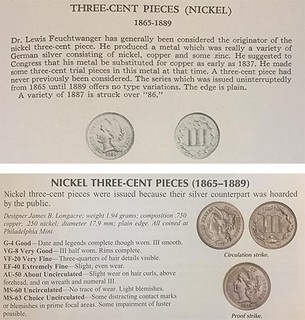
PREV ARTICLE
NEXT ARTICLE
FULL ISSUE
PREV FULL ISSUE
Last week Jeff Garrett published a nice article on the NGC site about how digital photography affected the numismatic hobby. Here's an excerpt - be sure to read the complete version online. -Editor  Coin photography has advanced by leaps and bounds in recent years. Some may be interested in a short history of the subject. Coin photography has advanced by leaps and bounds in recent years. Some may be interested in a short history of the subject.
The earliest regular auction catalogs for rare coins in the United States began in the 1850s or so. These early catalogs illustrated coins with the use of woodcuts. That process of illustration had been used for centuries in all forms of media, from books to newspapers. The limitations of this form of illustration are obvious. You get an idea of what the coin type looks like, but no indication of the actual coin’s appearance. Over the years, I have run across the actual woodcuts used for catalogs, and these are quite collectible themselves. The first United States auction catalog to use actual photographs was the 1868 Cogan sale of the McKenzie collection. Early auction catalogs are highly collectible, and over the next several decades, many extremely important collections were auctioned. These early sales by the likes of Chapman, Elder, Mehl and many others are very useful for researchers when studying pedigrees for important coins. Several years ago, a German catalog from 1884 sold for $4,700, mostly because the catalog was the first to feature a photograph of an 1804 Silver Dollar (actually a photo of a plaster cast; the actual coins were deemed too shiny to photograph). Many of these early catalogs are quite interesting to examine because of the staggering size of collections assembled in the early years of organized numismatics. The quality of photographs in these early catalogs varied extensively. A recent auction catalog by Kolbe and Fanning, offering an example of the 1911 Thomas Elder auction of the William Woodin collection, states “extremely rare, with remarkable photographic plates painstakingly executed by the multi-talented Edgar Adams, one of the most prolific American numismatic researchers and photographers of the early twentieth century.” The catalog sold for $2,937. The Chapman Brothers were also well known for the quality of photographic plates used in their catalogs. From 1868 until around the 1970s, most auction catalogs used the same standard black-and-white illustrations. The quality of images varied greatly from company to company. The recent incredible advances in cameras in our smartphones has been a boom for dealer productivity, as well. I can locate a rare coin on the bourse floor, shoot an incredible image, and text that image to a client in seconds. These tools are also being used with great efficiency on numismatic social media sites. The ease of use, low cost and quality, has leveled the playing field for professional numismatics. A lot of rare coin business is being done around the world because of this new technology. Even with the many tools available, digital photography and editing is an art. For anyone interested in learning the craft of digital photography, you should consider attending the ANA Summer Seminar. Tom Mulvaney and a few others teach classes each summer in Colorado Springs. The weeklong classes teach the basics of digital photography and editing. The classes are very popular, and most students rave about how much they learn in a short time. Collectors or dealers who want amazing coin photographs, but lack the necessary skills, should consider the imaging services of NGC. Their Photo Proof and Photo Vision imaging are among the best in the business. To read the complete article, see:  Wayne Homren, Editor The Numismatic Bibliomania Society is a non-profit organization promoting numismatic literature. See our web site at coinbooks.org. To submit items for publication in The E-Sylum, write to the Editor at this address: whomren@gmail.com To subscribe go to: https://my.binhost.com/lists/listinfo/esylum All Rights Reserved. NBS Home Page Contact the NBS webmaster 
|